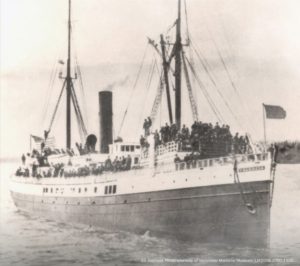A few minutes before midnight on January 22, 1906, a large passenger steamer packed with passengers veered from its course during a heavy gale and smashed into a reef off the southwest coast of Vancouver Island, its hull breached and flooding with icy seawater. The lights failed on the ship, plunging the terrified passengers into blackness. Screaming wind and rain thrashed them as they hysterically tried to board life rafts, unaware that they were blindly rushing to their deaths. Violent waves capsized several of the small boats, throwing their occupants into the sea, where their bodies were swept away or repeatedly dashed upon the rocky cliffs.
The ordeal lasted 40 hours. There were nine officers and 56 crew members on board, as well as at least 108 passengers; 37 people survived, 12 of which were passengers. All of the women and children passengers died.

This is the story of the SS Valencia, considered one of the worst maritime disasters of the region, and you can learn all about it at a new exhibit at the Maritime Museum of British Columbia (MMBC). The exhibit is comprised of mostly text, diagrams, and photographs, which recall the intimate details of the catastrophe, including several archived front-page newspaper spreads. It also contains a few artifacts from the wreck.
MMBC associate director Brittany Vis says that the incident is significant to BC maritime history because it of its magnitude and the number of avoidable tragedies that occurred.
“It’s one of the best-known shipwrecks on the coast here on Vancouver Island,” she says. “The west side of Vancouver Island is known as the graveyard of the Pacific, so there’s been a lot of shipwrecks in the area, and the Valencia is one of the most significant of those just simply due to how that shipwreck ended up playing out, and the number of lives lost.”
Vis says the reason the area is so dangerous is due to a perfect storm of natural factors.
“It’s a very rocky area, and it’s difficult to navigate, and the currents are very strong in that area, so, especially historically, before navigation techniques have increased and gotten better, it was just very easy for ships to get off course and then hit rock,” she says. “And a lot of these shipwrecks had occurred in the fall and winter when the storms on the west coast could be quite strong, as well.”
Included in the exhibit is a section providing information on how traumatic events impact the brain. Vis says that when considering the fascinating spectacle of shipwrecks, the impact of post-traumatic stress on the survivors can often be overlooked.
“In this exhibit we talk a bit about the effects of trauma on the brain, and I think that’s an area that isn’t often discussed in terms of shipwrecks. Like, most people are really interested and fascinated by the story of how shipwrecks unfolded, but by taking some time to consider now what we know about the brain and how the brain reacts to situations, I think it can add a whole other level of thinking,” she says. “People experience trauma in so many different ways and I think that just by simply understanding what happens to the brain, people can then have more compassion for people who have experienced trauma, and possibly for themselves, as well.”
Vis says that while macabre real-life stories can be a form of chilling entertainment, it’s important to remember that the victims were real people.
“People are a bit morbid and creepy and we like to hear about these kind of darker horrific stories, but what we don’t really stop to consider is, what did that mean for the individuals on board? How did that actually play out for them?” she says. “Every time I come across these personal stories, it’s definitely very eye-opening.”
SS Valencia: A Theatre of Horror
Until Thursday, September 2
The Maritime Museum of BC
mmbc.bc.ca
